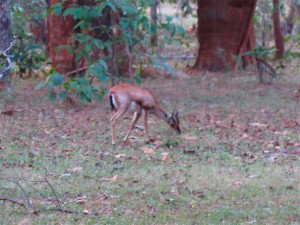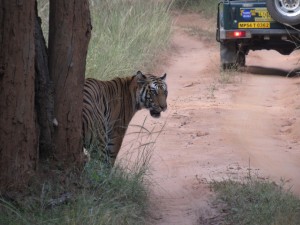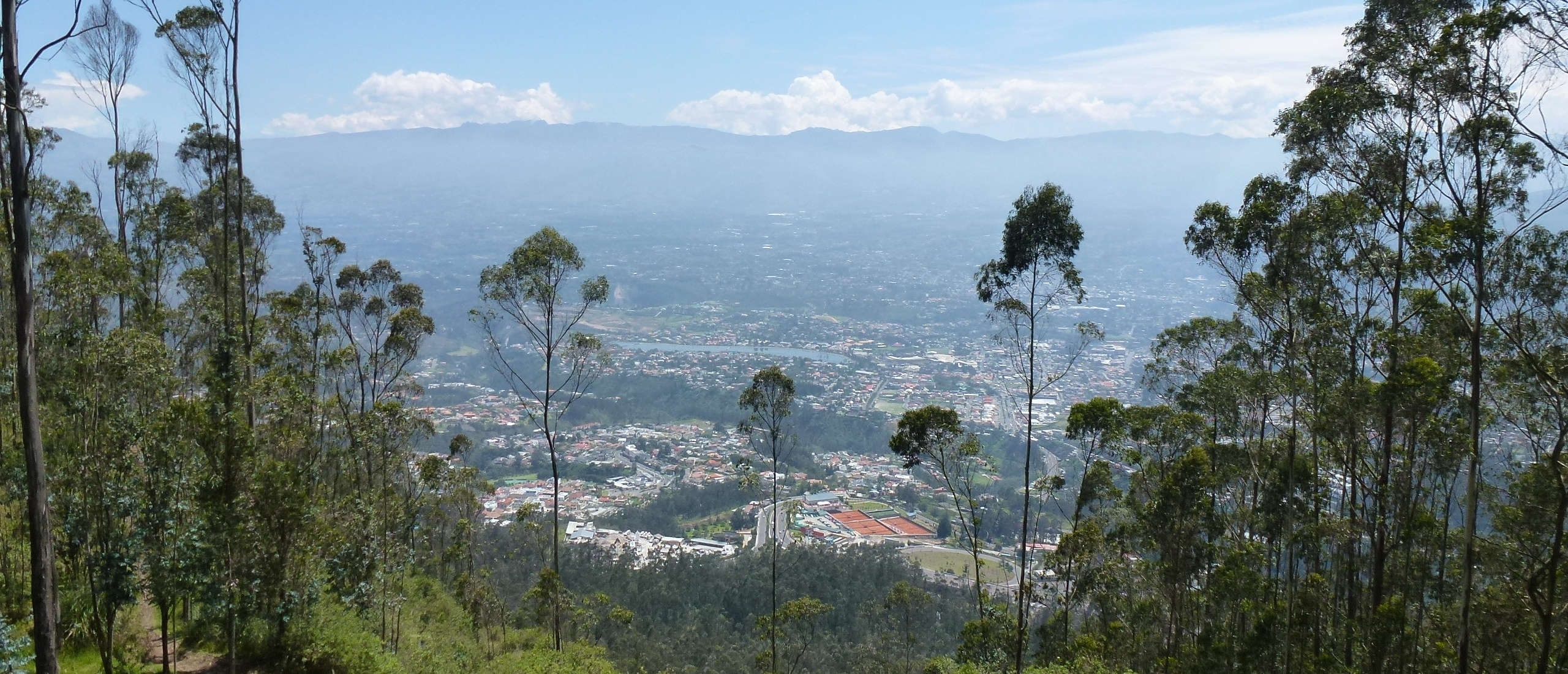
Tiger, Tiger, Gypsy, Gypsy As I briefly described at the end of my first update of this Great Indian Adventure of 2015, Rosemary Fox and I arrived in the central Indian state of Madya Pradesh by overnight train from Delhi, a journey that went smoothly and without complications. A driver was waiting for us at Katni station, from where we drove for several hours through rolling and lightly wooded countryside and a few rather shabby villages for much of the day, until we reached the entrance of Bandhavgarh National Park, where we turned off the main road onto a dirt track before finally arriving at Tiger Trails, our home for the coming five nights. The resort was attractively laid out next to a couple of small ponds, one of which played host to a resident Little Cormorant, which remained faithful to its one post throughout our stay. The following four days saw us building up a routine of early morning and afternoon safaris inside the Park, bumping along the forest tracks in a series of Maruti Suzuki Gypsies, those workhorses of Indian wildlife tourism, in the hope of encountering wildlife. Rosemary and I are not keen on the modern style of tiger tourism, which we had experienced at its worst last year in Corbett National Park, with hordes of vehicles racing along the jungle trails in a desperate frenzy to have their clients get the best views of a tiger, in the hope perhaps of obtaining a larger tip. We instructed our driver and the guides we picked up each time from the park entrance that this kind of tourism was not what we wished to experience, stating also that we were more interested in seeing what other wildlife the park could offer rather than focusing entirely on tigers.
 A beautiful morning scene in the jungles of Bandhavgarh
A beautiful morning scene in the jungles of Bandhavgarh
Although it was of course a privilege to enjoy the beauty of these extensive Indian forests, it soon became clear that we had been spoiled by our previous experiences of wildlife watching in the north of the country, mainly in Corbett, Rajaji and Dudhwa National Parks. All three of these seem to host a far wider range of bird species, and even mammals seem more numerous there. The higher diversity and numbers of birds can perhaps be explained by these northern parks' proximity to the high mountains, offering a greater altitude range and meaning that bird species that come down to escape the winter chill take up their winter quarters here rather than further south. In any case, birds were noticeably few and far between, although I was delighted to encounter a small flock of a species I had sought in southern India last year without success, the impressive Malabar Pied Hornbill. On our penultimate day, in the afternoon we found ourselves unable to obtain a ticket to enter the main part of the park, so we opted for the buffer zone instead. We also had a different Gypsy driver, a much calmer and more relaxed one, so we were spared the bumping and swerving we had become used to. This improved our experience no end, and we were also treated to a good sighting of six Indian Gazelles, or Chinkara, a species we had not previously encountered. Jackals were also quite numerous, and we spotted one Indian Grey Fox. Our guides were amused when I commented that I had two species of fox on my day list: Indian Grey Fox and Rosemary Fox!
 A rather fuzzy picture of an Indian Gazelle, or Chinkara
A rather fuzzy picture of an Indian Gazelle, or Chinkara
Despite our high-minded intentions, it was not long before we found ourselves dragged into that seemingly unavoidable desperation to encounter the king of the jungle, although when we did finally connect, on our eighth and final safari, it was not with a king but rather two queens, two tigresses from neighboring territories, who were none too pleased to see each other. The first one came in from our left, scowling and looking uneasy. She stalked onto the road, and then scent-marked a tree, before wandering along the track away from us and towards her rival.
 The tigress spraying a tree and a Gypsy behind
The tigress spraying a tree and a Gypsy behind
 The tigress was uneasy at the presence of a rival female
The tigress was uneasy at the presence of a rival female
 Now she turned back to face her rival
Now she turned back to face her rival
At this point, Rosemary appealed to our driver to stop the vehicle to allow us to observe and photograph this magnificent beast, which by this time was looking none to pleased at the presence of the other tigress, who had appeared to our right. 'Mam, I cannot stop!', came our driver's response, as he slammed the Gypsy into gear and raced towards the tigresses, almost exactly neck and neck with two other Gypsies, the three of us completely blocking occupants of other vehicles behind from seeing. By now sadly my attention had shifted from the interaction between the two tigresses, who seemed unconcerned by the human frenzy that they had unwittingly unleashed, to the human behaviour I was witnessing. It was as if the very worst aspect of human nature had been released, with drivers jostling their vehicles into the melée, and drivers cursing each other. Suddenly a rending crash indicated that two Gypsies behind us had collided, luckily not seriously, but we were appalled by all this desperate competition that was going on around us. The second tigress then gave us an excellent viewing as she loped through the vegetation to our right, luckily for us away from the track where all the other vehicles were still jockeying for position.
 The tigress walked past us despite the frenzy of Gypsies nearby
The tigress walked past us despite the frenzy of Gypsies nearby
Rosemary and I both thought how shocked my grandparents would be to see such base behaviour, when surely the aim should be to enjoy the quiet experience of observing the tigers' natural behaviour, and to marvel at the majesty of these noble cats. So what is the solution? I have no answer. Perhaps the majority of tourists are quite happy with this form of wildlife tourism. Perhaps Rosemary and I are biased, knowing how my grandparents would have encountered tigers, either meeting them on foot, observing them quietly from the back of their well-trained elephant Balmati, or from a machan up a tree. And it is surely better that the tourists are limited to small areas of national parks, leaving the larger core areas to the wildlife, where animals can remain undisturbed by the human hordes. Following our time at Bandhavgarh, we spent a day driving to another renowned Tiger Reserve, Kanha. Here we also had eight Gypsy safaris, and rather similar to our experience in Bandhavgarh, we were struck by the relative paucity of wildlife sightings. In addition to the usual Spotted, Sambhar and Barking Deer, plus Nilgai and Wild Boar, the mammalian highlights of Kanha were Barasingha, or Swamp Deer. Although we had observed numerous Barasingha at Dudhwa last year, apparently the animals here belong to a different (sub-)species, the Dry Ground Barasingha (although we saw them standing in ponds), a highly endangered animal that occurs only in this area. From a low of about 50 individuals in the 1970s, their numbers have now picked up and are now standing at over 400.
 Two Dry Ground Swamp Deer on far from dry ground
Two Dry Ground Swamp Deer on far from dry ground
The other really impressive animal we encountered in Kanha was the Gaur, or Indian Bison. This enormous bovine was not new to me as I had the dubious pleasure of meeting it while on foot last year in Periyar National Park, and I can vouch for the size and muscular appearance of a full-grown Gaur bull, but from the safety of the Gypsy I was able to marvel at these extraordinary animals at a more leisurely pace. I wondered how they had avoided being exterminated by man, but as a form of cattle they are classed as holy by Hindus and are therefore less likely to be hunted for their meat. We saw perhaps 30 individuals in two herds.
 A bull Gaur is an impressive beast
A bull Gaur is an impressive beast
We did not connect with either tigers or leopards during our eight safari drives in Kanha, although signs of both were evident, and we heard the roar of tigers on several occasions. We did have one very fleeting viewing of a Sloth Bear, but it was gone before we really had time to register its presence. And so our stay near our second central Indian tiger reserve draws towards its close, and tomorrow we are off to Pench, our third. Let us see how we got on there, and whether we will be treated to a tiger or a leopard sighting when we are alone, and not surrounded by jostling Gypsies all vying to obtain the best view.
 Hanuman Langoor monkeys may be mischievous but they are also elegant
Hanuman Langoor monkeys may be mischievous but they are also elegant











